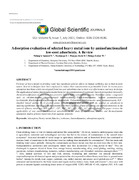| dc.description.abstract | Presence of heavy metals in drinking water has significant adverse effects on human wellbeing due to their toxicity
nature. Several techniques have been employed to reduce their concentration to permissible levels. In recent years,
adsorption has been widely investigated from low-cost adsorbents due to their cost effectiveness and easy in design.
The application of amino-functionalized adsorbents for decontamination of wastewater have been reported. Generally,
chemical modification of adsorbents has proved to have a higher adsorption capacity. Numerous amino- compounds
such as ethylenediamine, 3-aminopropyl triethoxysilane, Triethylenetetramine, Sodium paminobenzoate,
Acrylonitrile, Diethylenetriaminepentaacetic dianhydride, Polyaniline, Nitrilotriacetic acid, 3aminopyrazole, N,N -
dimethyl benzal aniline, Di (2-picolyl) amine, Ethylenediaminetetraacetic acid etc. grafted on adsorbents in
studying equilibrium, kinetic and thermodynamics has been reported. These adsorbents are applied extensively in the
removal of heavy metal ions such as Cu2+, Cd2+, Pb2+, Ni2+, Cr3+, Co2+, As5+ among others. The paper reviews the
applicability of vast amino-functionalized adsorbents in the study of equilibrium, kinetics and thermodynamic
adsorption studies of heavy metal ions from aqueous solutions | en_US |
